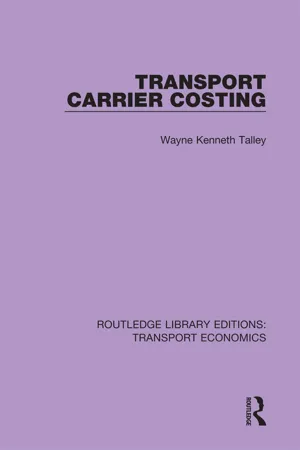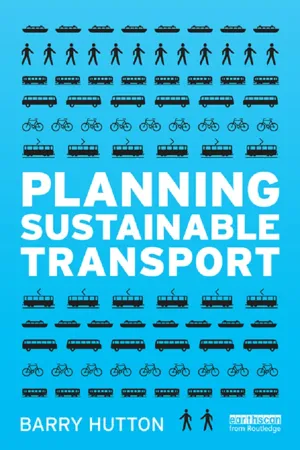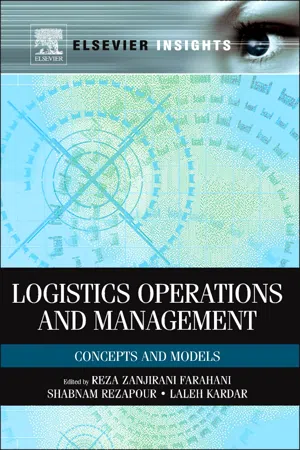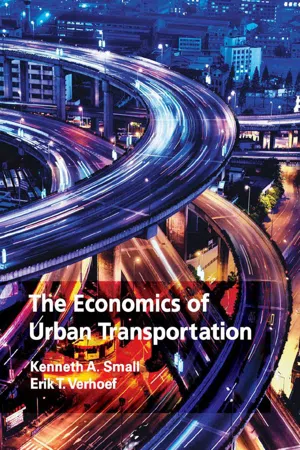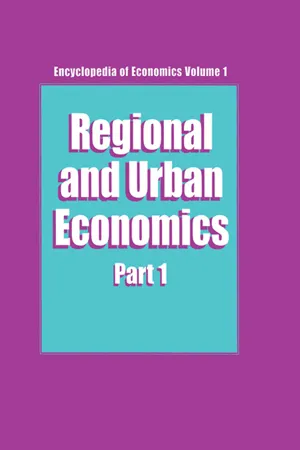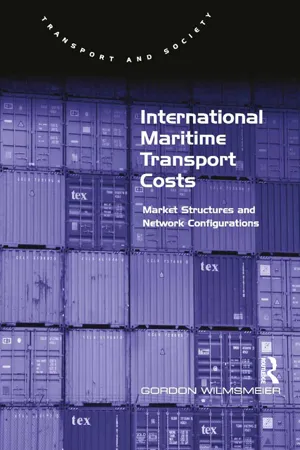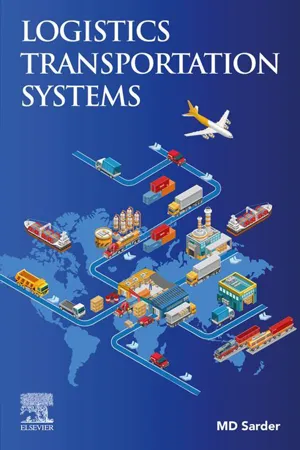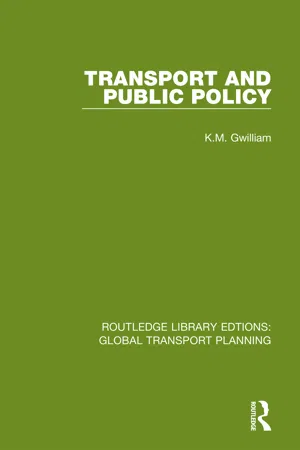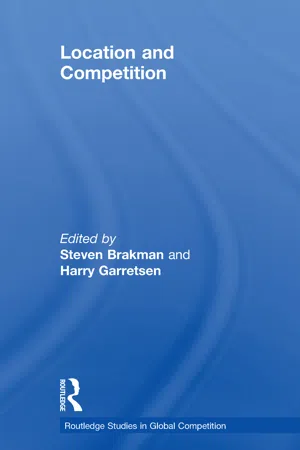Economics
Transportation Cost
Transportation cost refers to the expenses incurred in moving goods or people from one place to another. It encompasses various factors such as fuel, maintenance, labor, and infrastructure. In economics, transportation cost plays a significant role in determining the overall cost of production and distribution, impacting pricing, market accessibility, and trade patterns.
Written by Perlego with AI-assistance
Related key terms
10 Key excerpts on "Transportation Cost"
- eBook - ePub
- Wayne Kenneth Talley(Author)
- 2017(Publication Date)
- Routledge(Publisher)
Chapter 1An Overview of Transportation Costing1.1. Introduction
Transportation (or transport) is an activity that provides for the movement of goods or individuals from one place to another. Freight transportation involves the movement of goods; passenger transportation involves the movement of individuals. Freight transportation allows for bringing together at a given location the resources used in production processes as well as providing access to markets for the resulting products. Passenger transportation provides the means to move individuals from various origin-locations to various destination-locations.The demand for transportation is derived, i.e., transportation is a means to an end and not an end in itself. Freight transportation is demanded, since goods are demanded at locations where they can be used. Similarly, passenger transportation is demanded, since individuals demand goods or activities (e.g., recreational and dining activities) at destination locations. Transportation creates value by creating place and time utility. Place utility is created when goods are moved to a place where they can be used and when individuals are moved to a place where they can consume goods, enjoy various activities, and perform various job-related activities. Time utility is created when goods and passengers arrive at the desired time.In the movement of goods or individuals from one place to another, various costs will be incurred. The transportation firm (or carrier) that moves goods or individuals will incur cost; the passenger will incur a time cost; the shipper and receiver of the transported good will incur various logistics costs (e.g., inventory and order processing costs); if publicly-owned structures (e.g., highways and airports) are used, transportation movements will share their costs; and, finally, transportation movements may place costs (e.g., congestion and pollution costs) on society. Transportation Costing, as considered in this book, refers to determining the cost of transportation movements (freight and passenger) where all costs are considered. The purpose of this book is to address one of the above areas of Transportation Costing, i.e., transport carrier costing. Transport carrier costing refers to determining the costs to be incurred by a transportation firm (or carrier) in the transport of goods or individuals. - eBook - ePub
- Barry Hutton(Author)
- 2013(Publication Date)
- Routledge(Publisher)
Chapter 10 Transport costsIt is common to use ‘cost’ and ‘price’ as synonyms: they are not. The price is the money a buyer hands over to a seller for a good or for a service. The cost is the money the seller had incurred in providing it, including, of course, the prices paid to others for the inputs that went into its creation. Prices and costs form a chain: each actor in a supply chain gains revenue from the prices paid for the goods and services they sell but also incurs costs of providing them, costs which include not only the prices paid for raw materials and labour but also for the transport and storage needed to deliver to customers at the right time and place.The word ‘product’ is now used to cover both goods (tangible items like cars and petrol) and services (actions that are performed). This is unfortunate, because the distinction is very important. Goods like cornflakes may be stored on a shelf and taken whenever needed. Services cannot be stored: a bus company cannot run services during the night and store them, ready to be used in the morning rush-hour. Sometimes it is possible to store the resources which are to be committed to a service as a proxy for the service itself, rather like McDonald’s staff who are kept in a holding room to be called upon to satisfy surges in demand, or extra buses are put on the road at peak times. It is therefore more telling to say that services themselves have to be created and immediately consumed at particular times.In transport these particular times are very important: departure and arrival, delivery and transit times are major attributes of transport services. This fundamental trait makes it difficult to arrange effective competition at the point of use. Unlike shelved cornflakes which are constantly available, transport services, being time-specific, cannot be on constant offer, nor can competitive services be simultaneously available for selection. One company’s bus leaving at 09.03 is not the same ‘product’ as another company’s bus leaving at 09.05 – in economic jargon the two buses are not acceptable substitutes one for the other, in contrast to boxes of branded cornflakes stored side by side on the supermarket shelf, enabling one box to be instantly substituted for another on a consumer’s whim. - eBook - ePub
- Gilles Duranton, Vernon Henderson, William Strange(Authors)
- 2015(Publication Date)
- North Holland(Publisher)
An average ton of goods is worth less than one-tenth of this, while a typical ton of computer equipment is 15× as valuable. At least for relatively high value to weight products, time in transit is important. Moreover, the predominance of short-haul trade suggests that not only are Transportation Costs important, but that the geography of production is influenced by Transportation Costs. For example, the development of nineteenth century Chicago was heavily influenced by its location relative to its surrounding agricultural hinterland, as discussed in Cronon (1991). This points to an important econometric problem in interpreting the Transportation Cost data presented so far: these data describe equilibrium Transportation Costs. Therefore, they do not isolate the supply-side production function (or cost function) for transportation, but are rather influenced by both demand and supply. Although these data on Transportation Costs are still suggestive, they capture both the cost of transportation (supply) and the endogenous organization of economic activity in space in response to the cost of transportation (demand). This presents important and difficult econometric problems, to which we return below. Another striking feature of microdata on trade and production is the finding of Atalay et al. (2013) that most vertically integrated firms actually ship very little between plants. From the above, we have the puzzling collection of facts: the cost of moving goods is a small fraction of their value, most shipments occur over very small distances, most shipments do not travel by the cheapest mode, and the time cost of freight is probably important. One possible way of rationalizing this combination of findings is that there is something valuable about proximity other than the reduction in Transportation Costs—that is, agglomeration effects including knowledge spillovers and idea flows - eBook - ePub
Logistics Operations and Management
Concepts and Models
- Reza Farahani, Shabnam Rezapour, Laleh Kardar(Authors)
- 2011(Publication Date)
- Elsevier(Publisher)
[18] , estimations are made for the specific external cost data for different transportation modes.Standard vehicle types that can be suitably used in this country are selected for different transportation modes. The selected vehicles are a general cargo ship with a capacity of 3300 deadweight tonnage for the seaway, a freight train with a capacity of 700 tons for the railroad, and a truck with a capacity of 20 tons for the road.The mathematical formulation for calculating the Transportation Cost of a unit of cargo derived in this research is:(7.31)whereCk (t) denotes the investment cost per unit of cargo or passenger,Cf (t) is the fuel and lubricant costs per unit of cargo or passenger,Cm (t) is the operational and maintenance costs per unit of cargo or passenger,Cex (t) is the external costs per unit of cargo or passenger,Ys (t) is the number of annual cargoes and passengers or the number of cars that can be carried in a ferry,UT is the total cargo or passenger cost per unit.Results of the Study
The total cost of a unit of cargo in sea transportation consists of 26% investment cost, 32% fuel cost, 35% operational and maintenance cost, and 7% external cost. These percentages for railroad transportation are 22% for investment, 46% for fuel, 30% for operations and maintenance, and 2% for external costs. For road transportation, these values are 14%, 60%, 17%, and 9%, respectively.An analysis of the figures for sea transportation revealed the following points: It is considered that a fullness ratio of 60% is the lower limit for sea-cargo transportation, which may change according to route lengths. Thus, the fleet size and the optimal vessel capacity can be determined by taking into consideration the annual cargo potential on a given sea transportation route. - eBook - ePub
- Kenneth A. Small, Erik T. Verhoef(Authors)
- 2007(Publication Date)
- Routledge(Publisher)
Because service quality is so important to the demand for transportation, we must also include it in any supply analysis. One way to do so is to define quality dimensions for each output. This is conceptually natural, but cumbersome. Another way is to view consumers as part of the production process, as in Becker’s (1965) theory of household production; the level of service quality, like any other productive input, is then determined by conditions for efficient production. This approach, adopted here, treats user-supplied inputs, such as time, as if purchased in markets at prices equal to the values that are determined from demand analysis. In doing so, it moves such user inputs from the demand side to the supply side of the analysis and embeds them directly into cost functions.Knowledge of cost functions enables us to answer questions about the relative efficiency of various types of transportation and about the relative importance of various parts of the production process such as capital, user time, operator wages, public facilities, and even unintended spillovers to non-users. The discussion begins in the next section with basic cost concepts. Section 3.2 then surveys our knowledge of cost functions for public transit service. Sections 3.3 through 3.5 do the same for highway transportation, with an emphasis on private automobiles and congestion; these sections provide a variety of models of congestion and synthesize our knowledge of key quantitative parameters affecting the social cost of automobile transportation. Section 3.6 briefly compares the average costs of particular types of trips by various private and public modes.3.1 The nature of cost functions
The literature on Transportation Cost contains much confusion that can be avoided by using standard economic concepts and terminology as presented in, for example, Varian (1992). Useful reviews include Jara-Díaz (1982), Braeutigam (1999), and Pels and Rietveld (2000). What follows is our own synthesis.General definitions
A general description of technology, allowing for multiple outputs and inputs, is the transformation function:where q and x are vectors of outputs and inputs, respectively, and θ is a vector of parameters which may include service-quality descriptors. (Alternatively, services of different quality may be considered as different outputs in the vector q.) When there is just one output, (3.1 ) can be rewritten as a production function q(x;θ), giving q as a function of inputs and θ - eBook - ePub
- Richard J. Arnott(Author)
- 2013(Publication Date)
- Routledge(Publisher)
Section 4 , consists of describing pricing, investment, and strategic decisions: that is, transportation providers’ economic behavior or the normative criteria by which transportation analysts would like to influence that behavior.Because service quality is so important to the demand for transportation, we must also include it in any supply analysis. One way to do so is to define quality dimensions for each output. This is conceptually natural, but cumbersome. Another way is to view consumers as part of the production process, as in Becker’s (1965) theory of household production; the level of service quality, like any other productive input, is then determined by conditions for efficient production. This approach, adopted here, treats user time as though purchased in markets at prices equal to the corresponding values of time. In so doing, it moves user time from the demand side to the supply side of the analysis. By incorporating user time into the optimization problem that underlies the cost function, one obtains unexpected insights into such policy questions as optimal subsidies and the desirability of competition among transit operators.Knowledge of cost functions enables us to answer a great many questions about the relative efficiency of various types of transportation, and about the relative importance of various parts of the production process such as capital, user time, operator wages, public facilities, and even unintended spillovers to nonusers. The discussion begins in Section 3.1 with basic cost concepts. Section 3.2 then surveys our knowledge of cost functions for public transit service. Sections 3.3 through 3.5 do the same for highway transportation, with an emphasis on private automobiles and congestion; these sections not only provide a variety of models for incorporating congestion, but also synthesize our knowledge of key quantitative parameters affecting the social cost of automobile transportation. Section 3.6 - eBook - ePub
International Maritime Transport Costs
Market Structures and Network Configurations
- Gordon Wilmsmeier(Author)
- 2016(Publication Date)
- Routledge(Publisher)
Wilmsmeier et al. 2006) .Analysis of determinants of transport costs has been driven by economists rather than research in geography (e.g. Hummels 1999a , Micco and Perez 2001, Limâo and Venables 2001). Recent works in the field of transport geography only briefly discuss the topic of international transport costs. Rodrigue (2009) gives a list of determinants of international transport costs (see Table 3.1 ) and states that institutional effects should be analysed further. He does not provide any empirical evidence nor does he elaborate on the importance of each of the factors. Nuhn and Hesse (2006)Table 3.1 Conditions affecting transport costsCondition Factor Examples Geography Distance, physiography, accessibility Shipping between France and England vs. shipping between France and the Netherlands Type of product Packaging, weight, perishable Shipping coal Shipping flowers or wine Economies of scale Shipment size A 747 compared to 737 (passengers) A ULCC compared to a VLCC (freight) Trade imbalance Empty travel Trade between China and the United States Infrastructure Capacity, limitations, operational conditions The Interstate Mode Capacity, limitations, operational conditions A bus compared to a car Competition and regulation Tariffs, restrictions, safety, ownership The European Union, The Jones Act Source: http://www.people.hofstra.edu/geotrans/eng/ch7en/conc7en/table_conditionstransport.html (June, 2009). Copyright © 1998–2013, Dr Jean-Paul Rodrigue, Dept. of Global Studies & Geography, Hofstra University, New York, USA. Reprinted with permissionGouvernal and Slack (2012) analyse freight rates of one global carrier for a period of three years on selected global routes. They argue that economic distance as a measure reveals spatial patterns different to physical distance and thus argue in line with Wilmsmeier and Hoffmann (2008) that physical distance is an imperfect proxy for maritime transport costs. Further Gouvernal and Slack (2012) follow the argument of Wilmsmeier and Hoffmann (2008) - eBook - ePub
- MD Sarder(Author)
- 2020(Publication Date)
- Elsevier(Publisher)
Generally, the two major decisions that need to be made concern trading Transportation Costs over inventory costs and trading Transportation Costs over overall costs. When trading Transportation Costs over inventory costs, various factors have to be taken into consideration such as choosing the most appropriate transportation mode. Also, the effect of a transportation mode on a supply chain aids in the decision-making process; that is, does one transportation mode make the supply chain more customer responsive than the other even though it is quite expensive, or is there a cheaper mode that responds a lot more slower to customer demands than another? This is where the customer has to make the appropriate decision, which is usually based on cost. Whatever decision is taken must be a trade-off that best meets the interest of the consumer while retaining profitability of the firm. The task is to trade-off these characteristics to best meet the demands of the marketplace. Other factors include the ability to fill the transporting vehicle, protection of contents from theft, weather, etc. Another factor is shipping time and the availability of insurance on content delivery among other factors. The difficulty of arranging shipment due to strict governmental regulations is another issue. When considering delivery accommodation as a factor for instance, how many other modes need to be employed apart from the primary mode to get products to the final consumer? Seasonal considerations like weather, flight delays in rainy seasons, ECT. Size of the product to be shipped like cars, small electrical components, ECT, and finally, the perishability of the product been shipped. Establishing a symbiotic relationship takes time, but such relationship has significant advantages including lower costs, fewer disruptions in deliveries, more ontime deliveries, and better quality of products and services - eBook - ePub
- K.M. Gwilliam(Author)
- 2021(Publication Date)
- Routledge(Publisher)
count, that they are an important consideration in determining the distribution of traffic between agencies, which makes it vital that they should be sensibly based. It is normally assumed that, in a competitive situation, the profit motive will be sufficient to cause operators to relate their price to their costs of production in such a way as to secure that consumers’ requirements are satisfied with the least possible call on scarce resources. This is what we mean by saying that prices are sensibly based. Transport pricing is of special interest because there is reason to believe that there are complications in this sector which would prevent competition from bringing this about automatically. The variation between agencies of the proportionate significance of overheads, the immediate perishability of the product, the differing circumstances under which track is provided and the various social policies which have traditionally been forced on the transport sector combine to create special problems.The question of the social costs of road use and the effects of social obligations on the division of traffic between agencies will be considered in later chapters. In this chapter we abstract from these complications and consider the implications of various pricing policies in a sector where agencies with widely differing private cost structures are in competition.Prices and Costs
We have already stressed that transport services are multi-dimensional in character. The lowest priced haul is therefore not necessarily the cheapest from the point of view of the transport user who will also take into account the additional costs implied by differences in speed, reliability, accessibility, flexibility and so on. Nevertheless it is still important to devise a structure of transport prices which allocates traffic in such a way that for the provision of a required service the real cost to the community is at the lowest possible level. There may be alternative methods of pursuing this aim, involving the administrative direction of traffic; we shall concentrate, however, on the possibility of achieving it by the price system.Since transport users choose their agency at least partly on the basis of price it is important that charges should be related to the real value of the resources used in providing a service. Only if the value of the factors used is reflected in the price charged will individual users’ choices be translated into the most economical employment of resources in the transport sector as a whole. Can we not therefore merely instruct transport agencies to charge according to cost? - eBook - ePub
- Harry Garretsen, Steven Brakman(Authors)
- 2005(Publication Date)
- Routledge(Publisher)
2 Transport costs, location and the economy
Jan Oosterhaven and Piet RietveldINTRODUCTION
Economic activities and welfare are distributed anything but evenly in space. The explanation of the spatial pattern of dispersion and concentration rests on a combination of physical–geographical factors and the systematic impact of transport costs (Von Thünen 1826; Weber 1909; Lösch 1940). Historically, transport costs have put their stamp on the spatial economic structure of cities, countries and continents. But in real terms, transport costs have been falling for a long time. Some authors (for example Cairncross 1997) even claim that the role of transport costs has come to an end, resulting in the ‘death of distance’. Economic activities should have become footloose, implying the emergence of widely dispersed location patterns. However, many economic activities are characterised by strongly concentrated patterns, and that means that this conclusion is premature. Besides, there is no guarantee that the constant decrease in transport costs will continue. Systems of roads, railways and airports are experiencing bottlenecks in various parts of the world and this may well lead to an increase of transport costs in the future. Investments to overcome the bottlenecks are huge, and this calls for a critical analysis of the various effects of these investments.The aim of this chapter is to clarify the role of transport costs in the economy generally, and in spatial patterns of economic activities in particular. We start with a review of long-term developments in transport costs. We then discuss the contribution of transport costs to the accessibility of regions, after which we focus on the impact of transport on spatial patterns within metropolitan regions. We then review methods available for assessing the impact of transport infrastructure investments on regional and interregional economic performance and conclude that spatial general equilibrium models represent the best tool. Finally, an application of this type of modelling to a series of rail infrastructure proposals in the Netherlands is shown to provide relevant information.
Learn about this page
Index pages curate the most relevant extracts from our library of academic textbooks. They’ve been created using an in-house natural language model (NLM), each adding context and meaning to key research topics.
